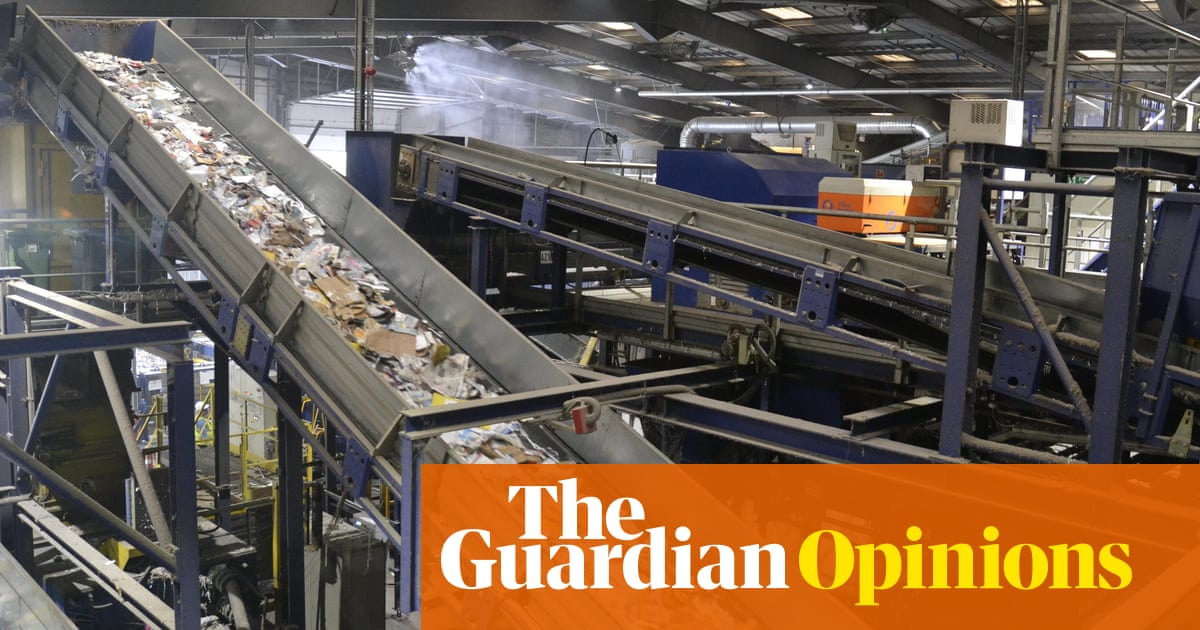Like all the best things in life, this story starts with an argument about bins. Admittedly, I could do better at recycling. I can try to chalk this up to having read too much about how all our plastic wasteultimately ends upin landfill sites in the poorest parts of south-east Asia. But I’m also lazy and so well-acquainted with cognitive dissonance that I could probably cry over the death scene in Bambi while comforting myself by chowing down on a giant haunch of venison.
My partner, Leo, is the total opposite: diligent and principled. Which is why she finally lost it with me for failing to put a plastic yoghurt tub in the recycling. I went on the defensive, citing half-imagined reports about megadumps in the Philippines and inescapable doom. She retaliated by booking us on an educational tour ofSouthwark Reuse and Recycling Centre.
There’s nothing quite like the fermented, sweet, umami scent of bin juice. And when it hit us, about 100m from the centre, I became even more convinced that we were going to be the only people on this tour. Minutes later, we were in a conference room packed out with waste management enthusiasts. There were about 20 of us in total, including a man with a blue ponytail, an elegant grey-haired woman in a classy shade of green, and an American. This is the inscrutable cross-section of binthusiasts. Ages ranged from mid-20s to early 70s. A hush fell over the room when one man – having perhaps misunderstood the “what does everyone love about London?” icebreaker question – announced that he’s glad he has cancer. All power to him. Another moment of tension came when, during the introductory slide show, we learned that in the UK, glass is recycled into insulation, and notmore glass. At this, one man (possibly the most passionate in the group) interjected, calling it a “tragedy”.
After a health and safety video on which we were then tested (yes, this tour of a waste management facility also includes an exam), we put on PPE and headed into the materials recovery facility. This is a bit like stepping inside an MC Escher print, in which rubbish is being moved by conveyor belts in seemingly every direction. This – the first stop for every single item placed in a blue bin by Southwark residents – is humbling to behold. Workers in stab-proof, elbow-length gloves sift through our detritus, aided by whirring, churning, and sometimes AI-powered machines. I focused on individual items, visible for seconds in the endless current; a tuna can, a cuddly leprechaun toy, some pages of sheet music. I began thinking about how every single one of these objects was interacted with before being thrown away, and soon started to feel dizzy. Yes, the tour guide told us about the weirdest thing that ever showed up in this place: a live cat. Don’t worry, he survived, and they named him Lucky.
As I stood there in a hard hat, awed by how disgusting and innovative our species is, I realised thateveryoneneeds to see this. Back when pilgrimages were more of a thing in the west, people would travel to great, imposing spaces to think about how gross and sinful they are. Today, maybe a visit to a mechanised garbage cathedral like this can fulfil a similar purpose. It’s all too easy to imagine that the things we throw away cease to exist. But to be confronted by thousands upon thousands of forgotten objects is more than a sad, smelly day out: it’s a reminder that we’re part of something absolutely massive.
Did I have a religious experience in a recycling centre? Did I see the face of God in a shredded bag for life? No and no. But I did learn that people try to recycle dirty nappies (who are you and why? Stop immediately) and I will think twice before chucking a yoghurt pot in the main bin. While I’m still aware of the limits to plastic recycling, we can at least give it a fighting chance.
There’s something hopeful about encountering a group of people who want to be on a tour of a waste management facility. People who think deeply about where our discarded crap ends up may not be in the majority, but there are way more of them than you might think.
Next stop (and one friend suggested we save this one for our honeymoon): a sewage treatment plant.
Eleanor Margolis is a columnist for the i newspaper and Diva
